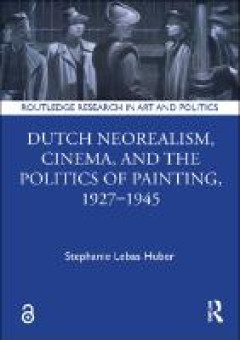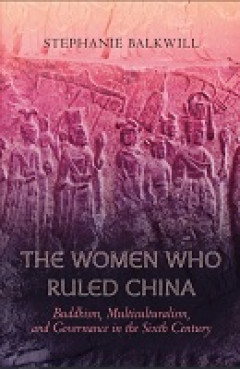Ditapis dengan
E-book Arts of The Samurai
The legends of the Japanese warrior-statesmen, referred to as the samurai, are renowned for accounts of military valor and political intrigue—epic conflicts between powerful lords, samurai vassals, and the imperial court—as well as accounts of profound self-sacrifice and loyalty. The term samurai is derived from the word saburau, or “one who serves.” The evolution of the samurai from mo…
- Edisi
- -
- ISBN/ISSN
- -
- Deskripsi Fisik
- 134 hlm
- Judul Seri
- -
- No. Panggil
- 739.7 KAO a

E-book Dutch Neorealism, Cinema, and the Politics of Painting, 1927–1945
This study offers a radically new perspective on Dutch Neorealism, one that emphasizes the role of film as an apparatus, the effects of which, when emulated in painting, can reproduce the affective experience of film-watching. More of a tendency than a tightly defined style or "ism," Neorealism is the Dutch variant of Magic Realism, an uncanny mode of figurative painting identified with Neue Sa…
- Edisi
- -
- ISBN/ISSN
- 9781040135129
- Deskripsi Fisik
- 234 halaman
- Judul Seri
- -
- No. Panggil
- 900.0 HUB d

E-book The Women Who Ruled China: Buddhism, Multiculturalism, and Governance …
In the late fifth century, a girl whose name has been forgotten by history was born at the edge of the Chinese empire. By the time of her death, she had transformed herself into Empress Dowager Ling, one of the most powerful politicians of her age and one of the first of many Buddhist women to wield incredible influence in dynastic East Asia. In this book, Stephanie Balkwill documents the Empre…
- Edisi
- -
- ISBN/ISSN
- 9780520401815
- Deskripsi Fisik
- 262 halaman
- Judul Seri
- -
- No. Panggil
- 951 BAL t
E-book Circulation and Control : Artistic Culture and Intellectual Property i…
The nineteenth century witnessed a series of revolutions in the production, circulation, and reproduction of images. Thanks to changes in printing and imaging technology and shifts in the practices of artists, publishers, and photographers, images became more readily available, in a wider range of media than ever before. Working in the new field of lithography,…
- Edisi
- -
- ISBN/ISSN
- 9781800641488
- Deskripsi Fisik
- 545 hlm
- Judul Seri
- -
- No. Panggil
- 346.04 ALE c

E-book Signs of Disability
How can we learn to notice the signs of disability? We see indications of disability everywhere: yellow diamond-shaped “deaf person in area” road signs, the telltale shapes of hearing aids, or white-tipped canes sweeping across footpaths. But even though the signs are ubiquitous, Stephanie L. Kerschbaum argues that disability may still not be perceived due to a process she terms “dis-atte…
- Edisi
- -
- ISBN/ISSN
- 9781479811175
- Deskripsi Fisik
- 247 halaman
- Judul Seri
- -
- No. Panggil
- 362.2 KER s
E-book Buddhist Statecraft in East Asia
Perhaps the best way to approach this volume on Buddhist statecraft is with the following observation in mind: the proper functioning of the state is a Buddhist concern. Throughout the history of the tradition, Buddhist have engaged questions of statecraft in their creation and propagation of texts, doctrines, rituals, institutions, and visual cultures. Political actors have, in turn, employed …
- Edisi
- -
- ISBN/ISSN
- 9789004510227
- Deskripsi Fisik
- 202 hlm
- Judul Seri
- -
- No. Panggil
- 294.3 BAL b
E-book Medicine – Religion – Spirituality : Global Perspectives on Tradit…
In the history of religions, tasks such as curing bodily ailments, treating the sick, and dealing with dying were often assigned to religious experts. Con-cepts such as the body, illness, and health were anchored in the world views and practices of the respective religious traditions. As Pamela Klassen (2016: 401) writes: “Medical knowledge and techniques have often emerged di-rectly…
- Edisi
- -
- ISBN/ISSN
- 9783839445822
- Deskripsi Fisik
- 275 hlm
- Judul Seri
- -
- No. Panggil
- 615.5 BRU m
E-book Forests and Food : Addressing Hunger and Nutrition Across Sustainable …
As population estimates for 2050 reach over 9 billion, issues of food security and nutrition have been dominating academic and policy debates. A total of 805 million people are undernourished worldwide and malnutrition affects nearly every country on the planet. Despite impressive productivity increases, there is growing evidence that conventional agricultural strategies fall short of eliminati…
- Edisi
- -
- ISBN/ISSN
- 9781783741953
- Deskripsi Fisik
- 290 hlm
- Judul Seri
- -
- No. Panggil
- 338.1 VIR f
E-book The Spiritual Laws
I have always asked myself many questions, very profound questions. The kind of questions that are called existential questions. I have always wanted to know the reason for my life, the reason for all of our lives. Who am I? Why do I exist? Why do others exist? What are we doing here? Have we come here for anything in particular? Why are we born, why do we die? Where do we come from and where a…
- Edisi
- -
- ISBN/ISSN
- -
- Deskripsi Fisik
- 243 hlm
- Judul Seri
- -
- No. Panggil
- 230 GUI t

E-Book A Week to Forever
Amaya Jasmine Koesoemo tak pernah menduga, satu minggu bisa mengubah seluruh jalan hidupnya. Tujuh hari. Seratus lima puluh empat jam. Dan bum! Semua masa depan yang telah Amaya rancang bersama Caleb buyar begitu saja. Pertemuannya kembali dengan Dirgantara Hidayat setelah enam tahun berselang, ternyata mampu membangkitkan kembali kisah lama di antara mereka, kisah yang dulu diakhiri bahkan s…
- Edisi
- Cet. 1
- ISBN/ISSN
- 9786020305011
- Deskripsi Fisik
- 248 hlm; 1 MB
- Judul Seri
- -
- No. Panggil
- 899.2213 STE a

Benang merah timur - barat: Menggali kearifan sambil belajar bahasa mandarin.
- Edisi
- -
- ISBN/ISSN
- -
- Deskripsi Fisik
- xv /173 hlm;12 x 17,5 cm
- Judul Seri
- -
- No. Panggil
- 170 EKA b
- Edisi
- -
- ISBN/ISSN
- -
- Deskripsi Fisik
- xv /173 hlm;12 x 17,5 cm
- Judul Seri
- -
- No. Panggil
- 170 EKA b

Prezi for dummies : Making everything easier!
A one-stop resource for an exciting new Web-based, slide-free presentation tool! People who have been seeking a flashier version of PowerPoint have found it—and it's Prezi. A Web-based, slide-free presentation tool, Prezi allows users to create and give rich, Web-based presentations complete with dynamic content, contextual layouts, and eye-catching visuals. Prezi For Dummies gets you rapidl…
- Edisi
- cet. 1
- ISBN/ISSN
- 978047062586
- Deskripsi Fisik
- 336 pages 19 x 23,5 cm
- Judul Seri
- -
- No. Panggil
- 621.382 DIA p

DYLAN, I LOVE YOU!
- Edisi
- cet. 1
- ISBN/ISSN
- 978-979-3065-9
- Deskripsi Fisik
- 296 hlm;13,5 x 20 cm
- Judul Seri
- -
- No. Panggil
- 8X0 ZEN d
- Edisi
- cet. 1
- ISBN/ISSN
- 978-979-3065-9
- Deskripsi Fisik
- 296 hlm;13,5 x 20 cm
- Judul Seri
- -
- No. Panggil
- 8X0 ZEN d

KAPOK DEH JATUH CINTA
- Edisi
- cet. 1
- ISBN/ISSN
- 979-1133-35-2
- Deskripsi Fisik
- iv; 176 hlm;13,5 x 19 cm
- Judul Seri
- -
- No. Panggil
- 8X0 ZEN k
- Edisi
- cet. 1
- ISBN/ISSN
- 979-1133-35-2
- Deskripsi Fisik
- iv; 176 hlm;13,5 x 19 cm
- Judul Seri
- -
- No. Panggil
- 8X0 ZEN k

NOBODY'S PERFECT
- Edisi
- cet. 1
- ISBN/ISSN
- 978-979-17528-8
- Deskripsi Fisik
- iv; 240 hlm;13 x 20 cm
- Judul Seri
- -
- No. Panggil
- 8X0 ZEN n
- Edisi
- cet. 1
- ISBN/ISSN
- 978-979-17528-8
- Deskripsi Fisik
- iv; 240 hlm;13 x 20 cm
- Judul Seri
- -
- No. Panggil
- 8X0 ZEN n
 Karya Umum
Karya Umum  Filsafat
Filsafat  Agama
Agama  Ilmu-ilmu Sosial
Ilmu-ilmu Sosial  Bahasa
Bahasa  Ilmu-ilmu Murni
Ilmu-ilmu Murni  Ilmu-ilmu Terapan
Ilmu-ilmu Terapan  Kesenian, Hiburan, dan Olahraga
Kesenian, Hiburan, dan Olahraga  Kesusastraan
Kesusastraan  Geografi dan Sejarah
Geografi dan Sejarah